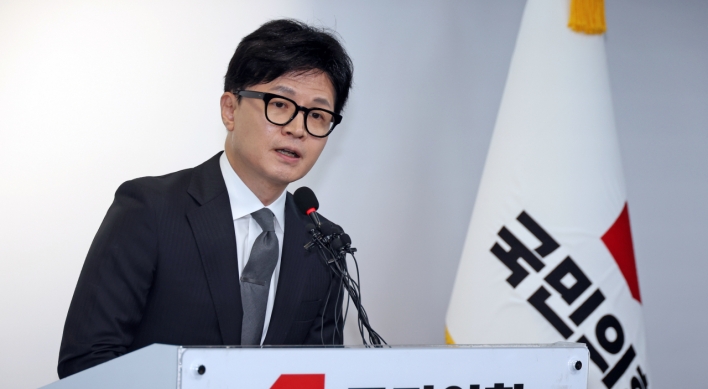Korea’s overall corporate profitability worsened in the first quarter from a year ago as oil costs rose and the local currency’s gain dented prices of export goods, the central bank said Tuesday.
The average ratio of operating profit to sales, a key barometer of profitability, reached 6.3 percent in the January-March period, down from 7.2 percent from a year earlier, the Bank of Korea said in a report based on a survey of 1,502 companies.
The first-quarter figure, however, increased from a 4.8 percent on-year expansion tallied in the fourth quarter of last year.
“The growth of corporate profitability slowed in the first quarter as raw material costs shot up and prices of exports goods like semiconductors and flat panels fell,” Son Won, an economist at the BOK, told reporters.
The ratio of local companies’ pre-tax net income to sales, another gauge of profitability, came in at 7.2 percent in the first quarter, down from 8.5 percent the previous year, the BOK said.
The Korean economy grew 6.2 percent last year, the fastest expansion in eight years, on the back of robust exports and improving domestic demand. The local economy is still on a solid recovery path, but its growth momentum is widely expected to slow down to the mid-4 percent range this year.
In the first quarter, the Korean won appreciated 3.5 percent to the dollar, compared with three months earlier.
The BOK said the interest coverage ratio of local companies rose last quarter as a fall in financial burdens somewhat offset worsened corporate profitability.
The average interest coverage ratio, which measures a firm’s capacity to cover financial costs with operating profit, came in at 502.2 percent in the cited period, up from 489.6 percent the previous year.
“Despite rate hikes, costs for corporate bond sales or lending declined compared with a year ago, easing financial burdens that companies had to shoulder,” he added.
Local firms’ indebtedness eased in the first quarter compared with the previous year, but their debt ratio rose from three months ago as companies’ overall profitability declined, the BOK noted.
The average ratio of debt to equity, a barometer of corporate indebtedness, reached 99.6 percent as of the end of March, down from 101 percent in the same period of last year. The ratio, however, was 97.7 percent at the end of 2010.
Exporters mostly fared better than domestic-focused firms, indicating that overall corporate growth was driven by bigger companies.
The BOK said exporters were more profitable and healthier than domestic-focused companies. Sales by exporters rose 20.9 percent last quarter while non-exporters saw their sales gain 13.1 percent.
By sector, the local construction industry was still reeling from the business setback with its cash flows severely deteriorated after it was hit by sour project financing loans, the central bank said.
As local builders were not able to meet financial needs through business activities, they had to rely on borrowing from banks, squeezing their cash flows, it added.
(Yonhap News)
The average ratio of operating profit to sales, a key barometer of profitability, reached 6.3 percent in the January-March period, down from 7.2 percent from a year earlier, the Bank of Korea said in a report based on a survey of 1,502 companies.
The first-quarter figure, however, increased from a 4.8 percent on-year expansion tallied in the fourth quarter of last year.
“The growth of corporate profitability slowed in the first quarter as raw material costs shot up and prices of exports goods like semiconductors and flat panels fell,” Son Won, an economist at the BOK, told reporters.
The ratio of local companies’ pre-tax net income to sales, another gauge of profitability, came in at 7.2 percent in the first quarter, down from 8.5 percent the previous year, the BOK said.
The Korean economy grew 6.2 percent last year, the fastest expansion in eight years, on the back of robust exports and improving domestic demand. The local economy is still on a solid recovery path, but its growth momentum is widely expected to slow down to the mid-4 percent range this year.
In the first quarter, the Korean won appreciated 3.5 percent to the dollar, compared with three months earlier.
The BOK said the interest coverage ratio of local companies rose last quarter as a fall in financial burdens somewhat offset worsened corporate profitability.
The average interest coverage ratio, which measures a firm’s capacity to cover financial costs with operating profit, came in at 502.2 percent in the cited period, up from 489.6 percent the previous year.
“Despite rate hikes, costs for corporate bond sales or lending declined compared with a year ago, easing financial burdens that companies had to shoulder,” he added.
Local firms’ indebtedness eased in the first quarter compared with the previous year, but their debt ratio rose from three months ago as companies’ overall profitability declined, the BOK noted.
The average ratio of debt to equity, a barometer of corporate indebtedness, reached 99.6 percent as of the end of March, down from 101 percent in the same period of last year. The ratio, however, was 97.7 percent at the end of 2010.
Exporters mostly fared better than domestic-focused firms, indicating that overall corporate growth was driven by bigger companies.
The BOK said exporters were more profitable and healthier than domestic-focused companies. Sales by exporters rose 20.9 percent last quarter while non-exporters saw their sales gain 13.1 percent.
By sector, the local construction industry was still reeling from the business setback with its cash flows severely deteriorated after it was hit by sour project financing loans, the central bank said.
As local builders were not able to meet financial needs through business activities, they had to rely on borrowing from banks, squeezing their cash flows, it added.
(Yonhap News)



![[Exclusive] Korean military set to ban iPhones over 'security' concerns](http://res.heraldm.com/phpwas/restmb_idxmake.php?idx=644&simg=/content/image/2024/04/23/20240423050599_0.jpg&u=20240423183955)

![[Graphic News] 77% of young Koreans still financially dependent](http://res.heraldm.com/phpwas/restmb_idxmake.php?idx=644&simg=/content/image/2024/04/22/20240422050762_0.gif&u=)



![[Pressure points] Leggings in public: Fashion statement or social faux pas?](http://res.heraldm.com/phpwas/restmb_idxmake.php?idx=644&simg=/content/image/2024/04/23/20240423050669_0.jpg&u=)









